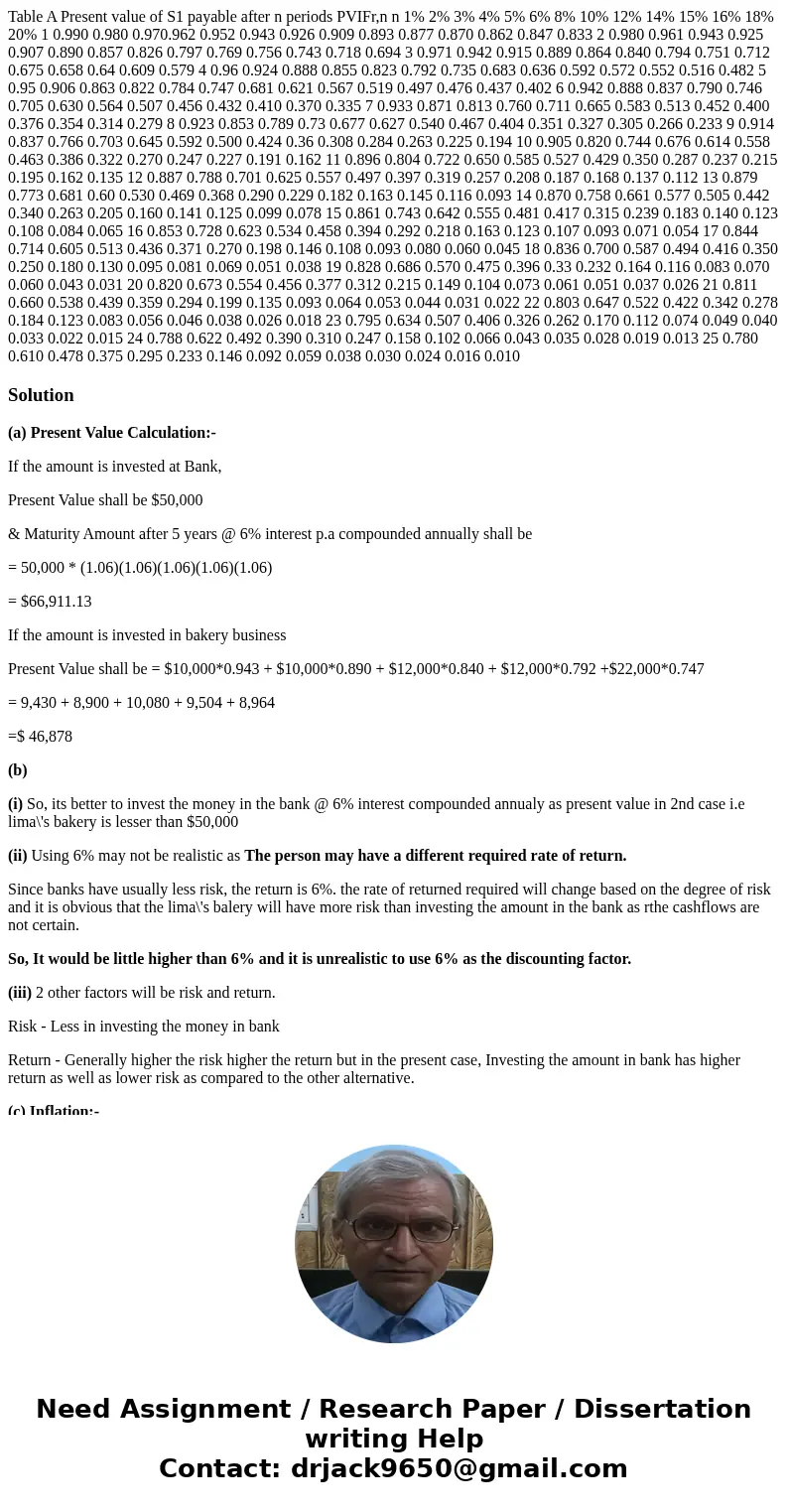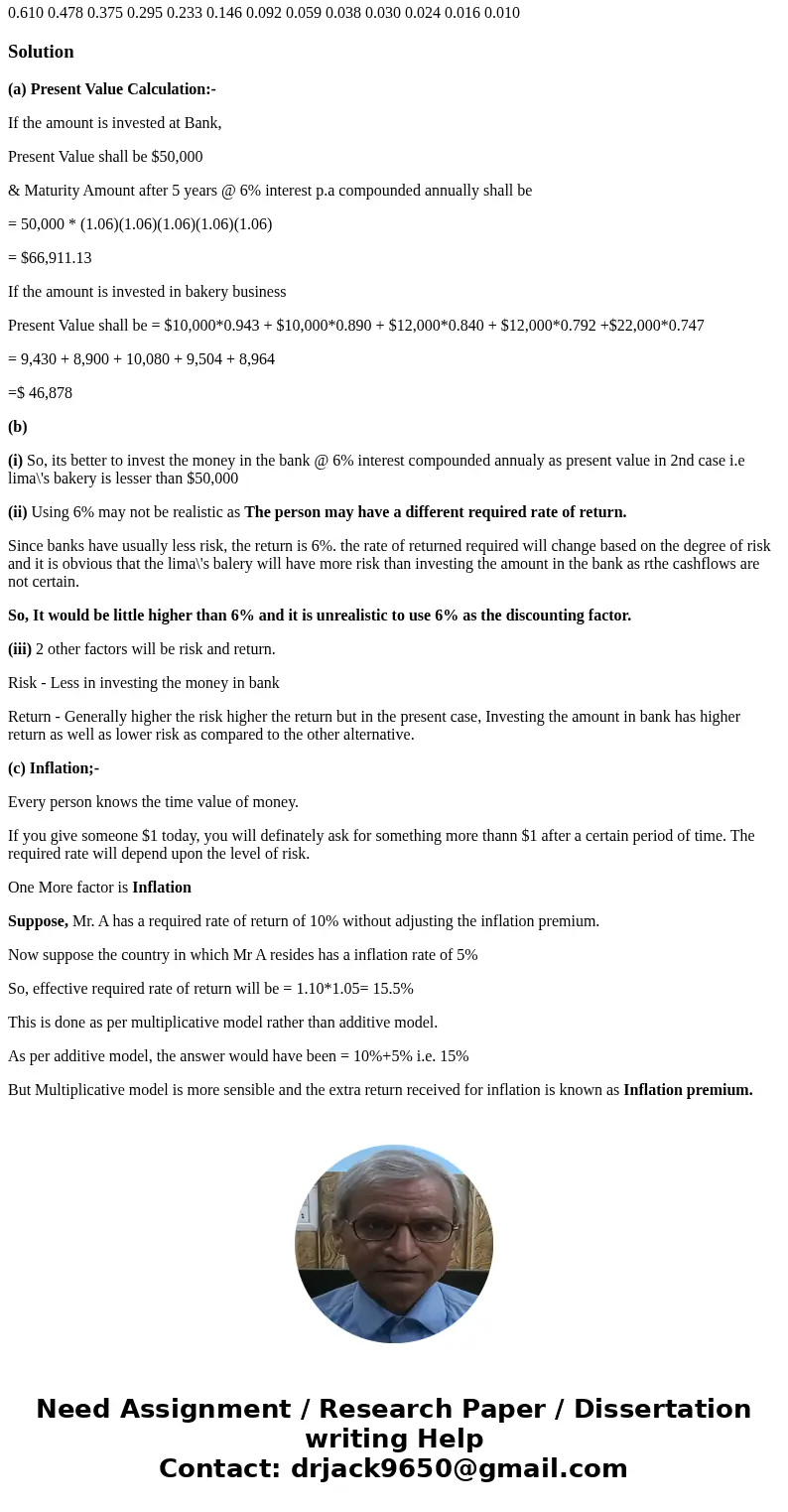Table A Present value of S1 payable after n periods PVIFr,n n 1% 2% 3% 4% 5% 6% 8% 10% 12% 14% 15% 16% 18% 20% 1 0.990 0.980 0.970.962 0.952 0.943 0.926 0.909 0.893 0.877 0.870 0.862 0.847 0.833 2 0.980 0.961 0.943 0.925 0.907 0.890 0.857 0.826 0.797 0.769 0.756 0.743 0.718 0.694 3 0.971 0.942 0.915 0.889 0.864 0.840 0.794 0.751 0.712 0.675 0.658 0.64 0.609 0.579 4 0.96 0.924 0.888 0.855 0.823 0.792 0.735 0.683 0.636 0.592 0.572 0.552 0.516 0.482 5 0.95 0.906 0.863 0.822 0.784 0.747 0.681 0.621 0.567 0.519 0.497 0.476 0.437 0.402 6 0.942 0.888 0.837 0.790 0.746 0.705 0.630 0.564 0.507 0.456 0.432 0.410 0.370 0.335 7 0.933 0.871 0.813 0.760 0.711 0.665 0.583 0.513 0.452 0.400 0.376 0.354 0.314 0.279 8 0.923 0.853 0.789 0.73 0.677 0.627 0.540 0.467 0.404 0.351 0.327 0.305 0.266 0.233 9 0.914 0.837 0.766 0.703 0.645 0.592 0.500 0.424 0.36 0.308 0.284 0.263 0.225 0.194 10 0.905 0.820 0.744 0.676 0.614 0.558 0.463 0.386 0.322 0.270 0.247 0.227 0.191 0.162 11 0.896 0.804 0.722 0.650 0.585 0.527 0.429 0.350 0.287 0.237 0.215 0.195 0.162 0.135 12 0.887 0.788 0.701 0.625 0.557 0.497 0.397 0.319 0.257 0.208 0.187 0.168 0.137 0.112 13 0.879 0.773 0.681 0.60 0.530 0.469 0.368 0.290 0.229 0.182 0.163 0.145 0.116 0.093 14 0.870 0.758 0.661 0.577 0.505 0.442 0.340 0.263 0.205 0.160 0.141 0.125 0.099 0.078 15 0.861 0.743 0.642 0.555 0.481 0.417 0.315 0.239 0.183 0.140 0.123 0.108 0.084 0.065 16 0.853 0.728 0.623 0.534 0.458 0.394 0.292 0.218 0.163 0.123 0.107 0.093 0.071 0.054 17 0.844 0.714 0.605 0.513 0.436 0.371 0.270 0.198 0.146 0.108 0.093 0.080 0.060 0.045 18 0.836 0.700 0.587 0.494 0.416 0.350 0.250 0.180 0.130 0.095 0.081 0.069 0.051 0.038 19 0.828 0.686 0.570 0.475 0.396 0.33 0.232 0.164 0.116 0.083 0.070 0.060 0.043 0.031 20 0.820 0.673 0.554 0.456 0.377 0.312 0.215 0.149 0.104 0.073 0.061 0.051 0.037 0.026 21 0.811 0.660 0.538 0.439 0.359 0.294 0.199 0.135 0.093 0.064 0.053 0.044 0.031 0.022 22 0.803 0.647 0.522 0.422 0.342 0.278 0.184 0.123 0.083 0.056 0.046 0.038 0.026 0.018 23 0.795 0.634 0.507 0.406 0.326 0.262 0.170 0.112 0.074 0.049 0.040 0.033 0.022 0.015 24 0.788 0.622 0.492 0.390 0.310 0.247 0.158 0.102 0.066 0.043 0.035 0.028 0.019 0.013 25 0.780 0.610 0.478 0.375 0.295 0.233 0.146 0.092 0.059 0.038 0.030 0.024 0.016 0.010
(a) Present Value Calculation:-
If the amount is invested at Bank,
Present Value shall be $50,000
& Maturity Amount after 5 years @ 6% interest p.a compounded annually shall be
= 50,000 * (1.06)(1.06)(1.06)(1.06)(1.06)
= $66,911.13
If the amount is invested in bakery business
Present Value shall be = $10,000*0.943 + $10,000*0.890 + $12,000*0.840 + $12,000*0.792 +$22,000*0.747
= 9,430 + 8,900 + 10,080 + 9,504 + 8,964
=$ 46,878
(b)
(i) So, its better to invest the money in the bank @ 6% interest compounded annualy as present value in 2nd case i.e lima\'s bakery is lesser than $50,000
(ii) Using 6% may not be realistic as The person may have a different required rate of return.
Since banks have usually less risk, the return is 6%. the rate of returned required will change based on the degree of risk and it is obvious that the lima\'s balery will have more risk than investing the amount in the bank as rthe cashflows are not certain.
So, It would be little higher than 6% and it is unrealistic to use 6% as the discounting factor.
(iii) 2 other factors will be risk and return.
Risk - Less in investing the money in bank
Return - Generally higher the risk higher the return but in the present case, Investing the amount in bank has higher return as well as lower risk as compared to the other alternative.
(c) Inflation;-
Every person knows the time value of money.
If you give someone $1 today, you will definately ask for something more thann $1 after a certain period of time. The required rate will depend upon the level of risk.
One More factor is Inflation
Suppose, Mr. A has a required rate of return of 10% without adjusting the inflation premium.
Now suppose the country in which Mr A resides has a inflation rate of 5%
So, effective required rate of return will be = 1.10*1.05= 15.5%
This is done as per multiplicative model rather than additive model.
As per additive model, the answer would have been = 10%+5% i.e. 15%
But Multiplicative model is more sensible and the extra return received for inflation is known as Inflation premium.


 Homework Sourse
Homework Sourse